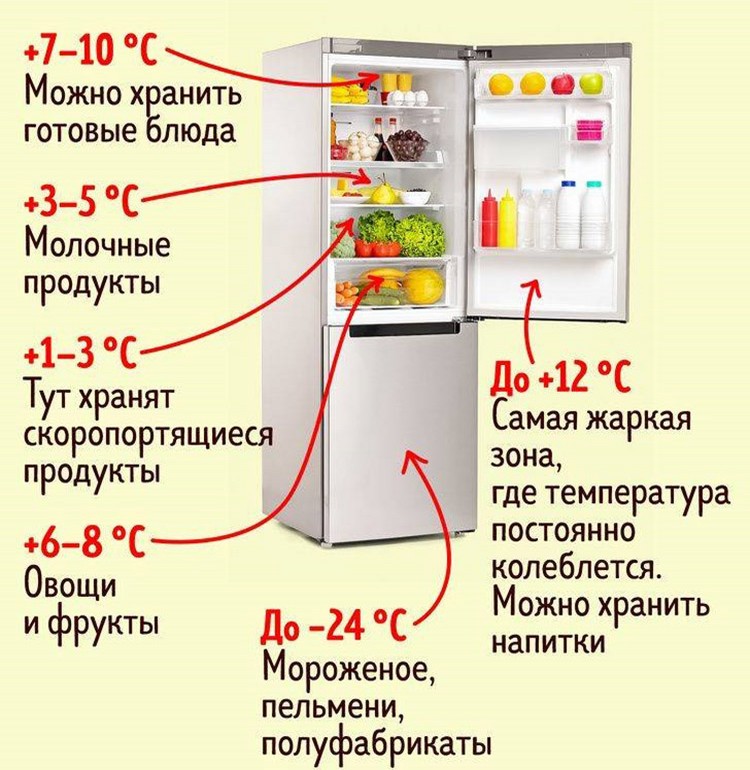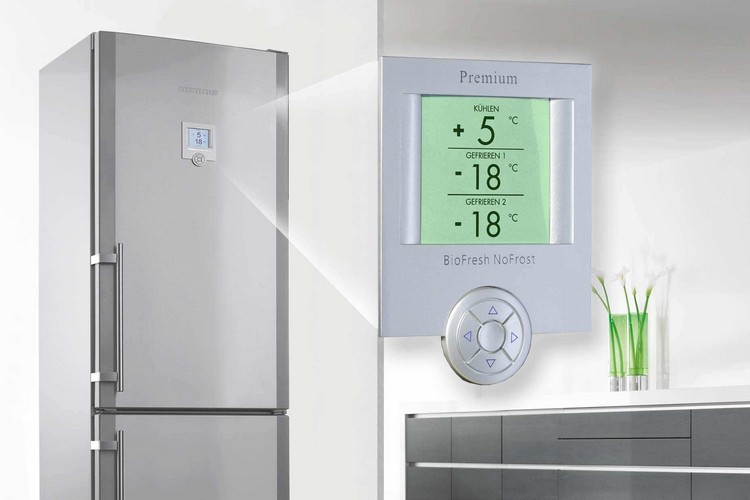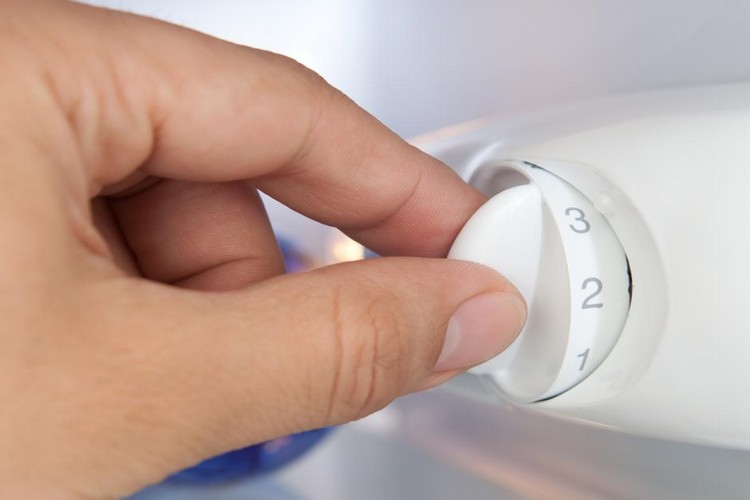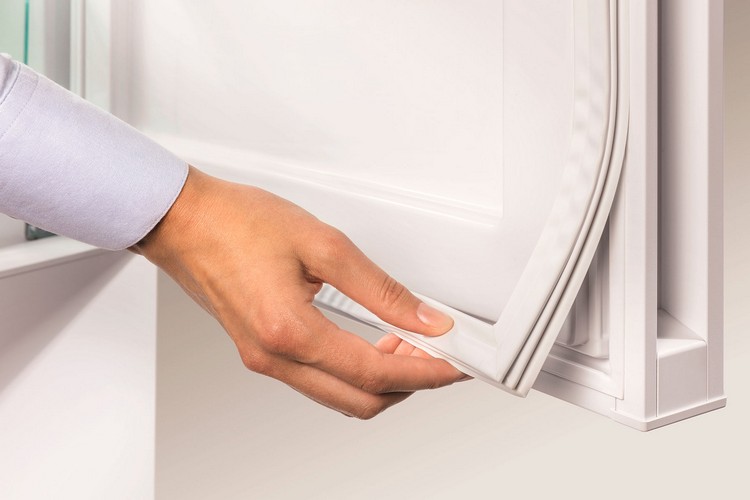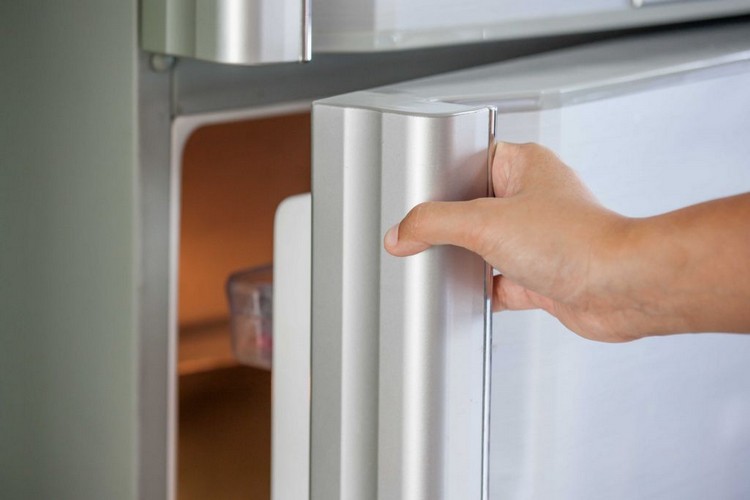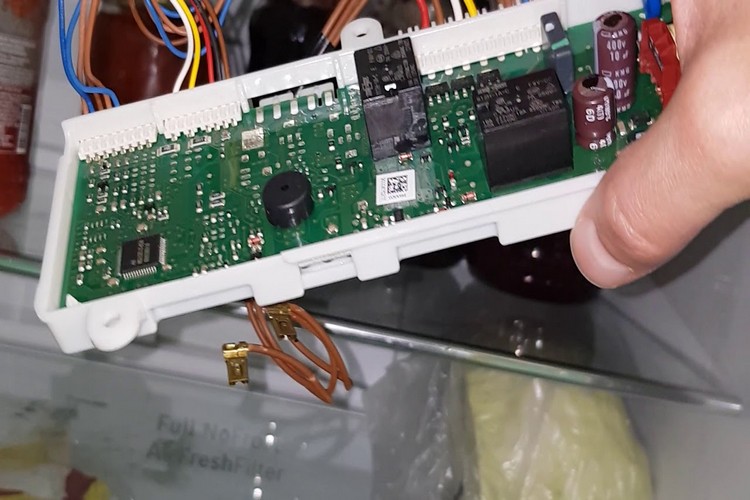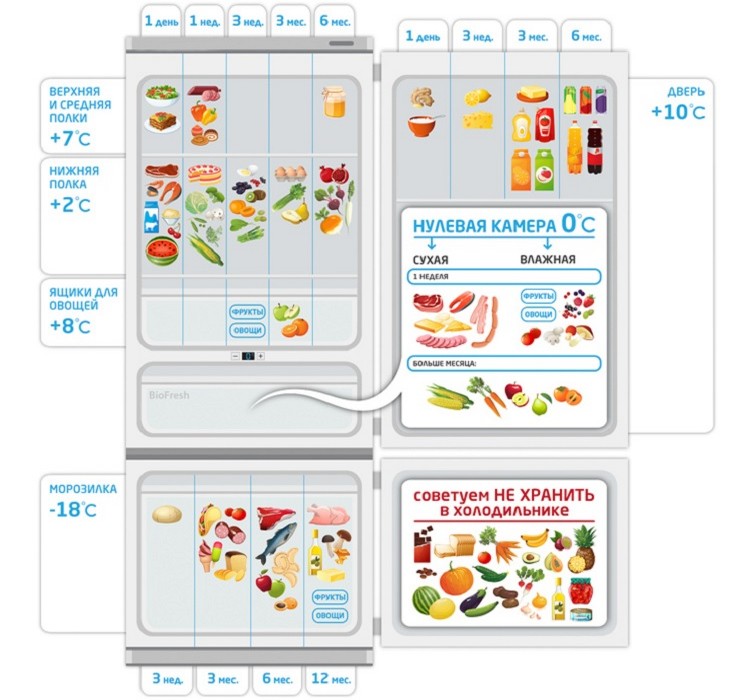What temperature should be in your fridge and how to set it correctly?
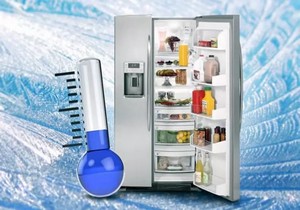 If you began to notice that the food stored in your refrigerator has been spoiling faster lately, or you began to find icing on the walls of the chamber, it may be a sign that the temperature inside the device is higher or lower than the established norm.
If you began to notice that the food stored in your refrigerator has been spoiling faster lately, or you began to find icing on the walls of the chamber, it may be a sign that the temperature inside the device is higher or lower than the established norm.
In this article, we'll talk about the optimum refrigerator temperature and break down common reasons why this norm might be violated.
Contents
- Temperature zones in the refrigerator compartment
- What temperature should be in the refrigerator?
- Why is the temperature rising in the chamber?
- Why does the fridge compartment freeze
- The norms of temperature for the compartments in the door
- What temperature to keep food in
- Adjusting the temperature
- Useful video
Temperature zones in the fridge compartment
Any refrigerated compartment is divided into several compartments, each of which represents a specific temperature zone:
- The main compartment is where most of the food is stored. This is the most versatile zone, with optimal storage temperatures.
- The lower shelves store raw meat, dairy products, and eggs because this area of the refrigerator has the lowest temperature.
- The upper shelves have the most stable temperature and are well suited for storing non-perishable foods.
- The side compartment, located on the inside of the unit door, is the warmest temperature zone of the whole refrigerator. Therefore, you should not store perishable foods, such as milk, in this compartment. Here it is recommended to put drinks, some condiments, medicines, etc., as well as foods that are best eaten cold.
- The pull-out drawers at the bottom of the chamber are used to store vegetables, fruits, and herbs. The temperature in these drawers, like the side compartment, is very warm and not suitable for storing perishable foods.
What temperature should be in the refrigerator?
The correct temperature in a household refrigerator is one at which the food is chilled but not frozen.
If the temperature is not low enough (e.g. about 15 degrees), the rotting process will gradually accelerate until the food loses its nutritional value and begins to emit an unpleasant odor.
In addition, an optimal temperature in the refrigerator not only has a beneficial effect on the storage of food, but also reduces energy costs.
Lower refrigerator temperatures stop the growth of bacteria that promote putrefaction.
So how many degrees should the refrigerator be? The ideal refrigerator compartment temperature should be above 0°C (the transition point from liquid to solid, i.e. freezing), but should not exceed 5°C (the temperature limit for effectively suppressing bacterial growth).
It is assumed that food products are best stored at 2°C.
However, it is very important to remember that there is considerable temperature stratification inside a cold room in the form of several temperature zones. It is on this basis that food should be arranged in the refrigerator.
Yes, the air temperature in the refrigerator is not the same, and it is this understanding that should be crucial when storing individual foods.
The refrigerator is designed to provide optimal circulation of cold air in different compartments and temperature zones.
Thanks to this, the food in your refrigerator stays fresh much longer, but at the same time it does not over-freeze.
Each refrigerator from modern manufacturers (Atlant, Indesit, Bosch, Lg, Haier, Liebherr, Samsung, Stinol) is equipped with a built-in thermostat which is responsible for the temperature mode. Some models have two such regulators - one for the refrigerator and one for the freezer. In the latter case, the temperature is always kept lower to prevent bacterial growth and defrosting of food.
Normally, the thermostat maintains an average temperature of -6 to -24°C. As for the freezer, a reasonable optimum temperature is around -18°C. Interestingly, at this temperature you can store supplies for up to one year.
Why the temperature rises in the refrigerator compartment
Sometimes it happens that the refrigerator stops maintaining the temperature and begins to heat up, and sometimes even leak. In this situation, the food begins to spoil quickly, and an unpleasant smell comes out of the refrigerator.
There can be several reasons for this problem: from improper operation to the malfunction of one of the components of the device.
Let's look at the main reasons why the temperature in the refrigerator may be rising, despite the selected settings.
Thermostat malfunction
As we mentioned before, the thermostat is a very important component of the refrigerator that is responsible for controlling the cooling system and helps distribute the cold evenly to all the temperature zones of the refrigerator.
If the thermostat is damaged, the refrigerator's temperature automatically decreases and it gradually begins to defrost.
A problem with the thermostat can cause the entire refrigerator to malfunction, so if it fails, you should find a replacement as soon as possible.
Temperature sensor provides the wrong signal
The temperature inside the refrigerator is also monitored by a special temperature sensor, whose main task is to monitor a constant level of heat in the chamber. If the desired temperature is not reached, the sensor starts flashing.
If the indicator does not work correctly, the refrigerator begins to receive incorrect data or does not receive anything at all. Thus, even if the thermostat is working, the unit simply can't get a signal to switch to the optimal mode.
But a malfunctioning sensor can lead not only to warming inside the chamber, but also, on the contrary, to excessive freezing. There are even cases when the temperature sensor simply gets covered in ice and hangs up, as a result of which the information is transmitted incorrectly.
Loss of refrigerant
Refrigerant is the main working substance of a refrigerator, which is responsible for the heat exchange in the refrigerating and freezing chambers.
In the liquid state, the refrigerant passes from the compressor to the condenser, located in the rear of the refrigerator, in the form of curved pipes. Through this device, the refrigerant is condensed under high pressure and becomes a gas that circulates throughout the chamber and provides cooling. In fact, the entire operation of the refrigerator is based on the transformation of the refrigerant from liquid to vapor.
During operation, the refrigerator alternately compresses (evaporates) and decompresses (condenses) the refrigerant, thus maintaining the temperature inside the unit.
Sometimes it can happen that the cooling system leaks, causing the coolant to leak.
Thus, if for some reason the refrigerant is lost, over time you will notice that the refrigerator no longer maintains its temperature, water begins to accumulate on the bottom of the chamber, and even if cooling occurs, it is uneven.
What to do in such a situation? The cause of the refrigerant leak must be repaired immediately. This is a complicated procedure, which is best entrusted to a service center.
The door seal is torn off
One of the most common and at the same time the easiest reasons why you may have problems with cooling is insufficient tightness of the chamber.
The rubber door seal of your refrigerator will eventually wear out and may even peel off. Therefore, you should regularly check its condition and, if necessary, replace it.
A good way to check the condition of the seal is to run a piece of paper between it and the door. Remember that a loose gasket, even just in one place, can cause a serious temperature malfunction in your refrigerator.
It is not difficult to install a new gasket on the door - even the services of a specialist will probably not be required. In most modern models of two-compartment refrigerators, the seal is easily installed by simple pressure, without the use of glue.
Defective defrosting coil
In modern refrigerating units, unlike the old Soviet models (for example, Minsk refrigerators), the defrost is performed automatically - with the help of the No Frost system.
The essence of the technology lies in the fact that, with the formation of ice and fixed temperature changes, a heating element (heater) and a special fan inside the refrigerator are activated, spreading warm air throughout the chamber. In this way the frost is thawed and defrosting takes place.
However, it may happen that the heater fails, and instead of starting from time to time, it runs continuously. In this case, the cooling system is disturbed and the refrigerator, instead of cooling, becomes a heater.
In this case, it is necessary to replace the heating element to prevent further malfunctions.
Why the fridge compartment is freezing
The formation of ice on the inside walls of the refrigerator is just as bad a sign as water accumulation due to its warming.
The refrigerator compartment is supposed to cool, but not freeze, which means the unit isn't functioning properly.
No, don't get it wrong: condensation buildup on the walls of the refrigerator is quite normal, but it should be within normal limits. A small layer of moisture or a few visible drops are acceptable, but not icing.
Let's consider the main reasons why this situation can occur.
Opening the fridge door too often
If you're a fan of keeping your home refrigerator door open for long periods of time, you may not be surprised that ice will eventually begin to accumulate inside.
The problem is that, as a result of temperature exchange, due to contact with warm air, moisture begins to condense abundantly in the chamber.
The same process we described in the breakdown of the temperature rise problem, but in this case the cooling continues to work, which means that all this water freezes and turns into accumulations of ice. You can also note the more intense operation of the compressor, which reacts to the temperature rise and tries to provide the unit with proper cooling, which leads us to this result.
Keep in mind that many other factors, such as ambient temperature, also influence the formation of moisture, because in summer the refrigerator cools much more intensively.
In addition, warm food is a frequent factor in rising temperatures and subsequent freezing. Always refrigerate pots and leftovers before putting them on the refrigerator shelf.
Incorrect temperatures
A common cause of refrigerator malfunction is incorrect temperature setting.
Check the temperature set in the fridge: if it is not equal to 5°С, then change the parameters to the optimal ones.
And also keep in mind that frequent and unreasonable opening of refrigerator door does not contribute to its correct operation. Warm air gets inside, and if there is too much air in your refrigerator, it will have a hard time keeping up with all that load.
Faulty thermostat
As we mentioned, the thermostat is a very important device that affects the activation of many other components of the unit, particularly the compressor.
If the thermostat suddenly stops reading what state to maintain the temperature in the chamber, it can simply shut down - then you're likely to encounter a lack of cooling.
Or it will go to the factory settings and work with disproportionate power, continuously cooling the chamber. In this case, it will need to be replaced.
Control module malfunction
The "brain" of the refrigerator is the control module, which is what controls the work of all the other components. Unfortunately, this also means that if something happens to it, the operation of the entire device will be disrupted.
The cause of the failure can be a short circuit or a problem with the power supply. In order to fix the defect, it is not enough to look at the instructions for the device. Unfortunately, you will have to call for service.
Therefore, if your refrigerator is accumulating ice, it is likely that the problem is caused by a failure in the system as a whole.
The temperature rating for the compartments in the door
The compartment inside the door is the warmest part of the refrigerator. It is designed for foods that require the most gentle and balanced refrigeration.
The refrigerator door usually has a tray for eggs, which should neither be overcooled nor kept warm. The side compartment is the perfect place to store butter or vegetable oil, various jams, preserves, ketchup, mustard, mayonnaise, juices in cartons and bottled sauces.
Many people also store medications on the refrigerator door, although this does not apply to all types of medications.
The average temperature in this area is 8-13°C.
At what temperature to store food
As you know, the temperature inside the refrigerator is distributed vertically, due to which there are separate temperature zones assigned to different groups of products.
Proper food storage implies knowing which shelves and compartments of the refrigerator are responsible for what, and what temperature they should have:
- Fruit and vegetables should be stored in special pull-out containers at the very bottom of the refrigerator compartment. Along with the side compartment on the door, this is one of the warmest places in the refrigerator. The average temperature there normally does not exceed 8°C.
- Fresh meat and fish should be placed on the bottom shelf, because the lowest refrigerator compartment temperature of 2°C remains there.
- For dairy products, eggs, cakes, meat products and cheese the middle shelves are designed with a temperature of 4-5°C. Soups are also recommended at this temperature.
- The top shelves, with an average temperature of 7°C, are the best place for products with a long shelf life (canned foods, strong alcoholic beverages, dry mixes, etc.).
Temperature control
The temperature of your refrigerator should not drop below 0°C, as at this temperature the food starts to freeze. It should also not be higher than 5°C, the upper limit for bacterial proliferation and food deterioration.
It is assumed that 2-3°C is the most optimal refrigerator compartment temperature but it actually depends, among other things, on the outside temperature. In countries with tropical climates, storage conditions will be different than in countries with continental climates.
Modern models automatically adjust the temperature inside the chamber to the ambient conditions, so if the climate changes drastically, the refrigerator will respond by changing the temperature mode.
But you are unlikely to notice the difference yourself if your refrigerator is in good working order. This is dictated by simple laws of physics: when warm summer air enters, it is not evenly distributed throughout the chamber, but rises.
Therefore, if the thermostat is set to the optimum temperature of 2°C, you will see 7°C on the top shelves, about 4-5°C on the middle ones and the same 2°C at the lowest level. The food storage conditions have not changed, only the average temperature has.
Useful video
To find out more about the average temperature in your refrigerator and its compartments, watch this video:



